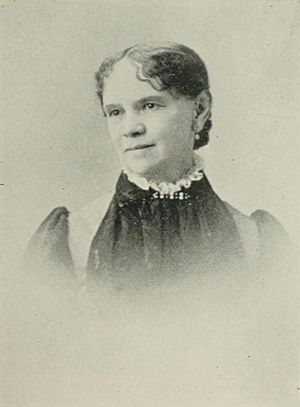Sophie Naylor Grubb facts for kids
Quick facts for kids
Sophie Naylor Grubb
|
|
|---|---|

"A Woman of the Century"
|
|
| Born | Sophronia Farrington Naylor November 28, 1834 Woodsfield, Ohio, U.S. |
| Died | November 5, 1902 Chanute, Kansas, U.S. |
| Occupation |
|
| Language | English |
| Nationality | American |
| Genre |
|
| Subject | temperance |
| Spouse |
Armstead Otey Grubb
(m. 1856) |
| Children | 5 |
Sophie Naylor Grubb (born November 28, 1834 – died November 5, 1902) was an American activist from the 1800s. During the American Civil War, she showed great energy and passion for helping others. This passion stayed with her throughout her life.
She wrote and published many small books and flyers about the Temperance movement. These were printed in seventeen different languages. She produced about 50 editions, each with 10,000 copies, every year. She also gave many talks about women's right to vote. In 1898, she held 75 meetings in Kansas to discuss this topic. Grubb passed away in 1902.
Contents
Early Life and Education
Sophronia Farrington Naylor was born in Woodsfield, Ohio, on November 28, 1834. People often called her "Sophie" or "Sophia."
Her father taught her directly at home. When she was seventeen, she graduated with a degree in Classics. This was from the Illinois Conference Female College, which is now called MacMurray College. She finished her studies in Jacksonville, Illinois, in the late 1850s.
Her Work as an Activist
When Sophie was nineteen, she became the head of the women's department at Chaddock College in Quincy, Illinois. In 1856, she married Armstead Otey Grubb in Missouri. They had five children together, including Sophia and Edith. Until 1861, she focused mainly on her family and home.
Helping During the Civil War
At the start of the American Civil War, Sophie and her family moved back to Quincy. During this difficult time, she showed how capable and enthusiastic she was. She loved her country and spent four years helping without pay. She worked in hospitals, army camps, and on battlefields.
Sometimes, she helped bring sick and injured soldiers from swamps and fields in the South. Doctors and nurses were scarce, so she even helped during surgeries. She also noticed the great needs of African Americans. Many refugees came to her husband's office asking for help. He would send them to their home, telling Sophie to provide for them.
This work became very demanding. So, Mrs. Grubb organized a public meeting. With her sister, Mrs. Shields, and others, she started a Freedmen's Aid Society. Over the next three years, they helped more than 3,000 African Americans who were in need.
Fighting for Temperance and Women's Rights
After the war, the Grubbs returned to St. Louis. As her sons grew up, Sophie became very concerned about the problems caused by alcohol. She decided to focus her efforts on the temperance movement. This movement worked to reduce or stop the use of alcohol.
In 1882, she was chosen to lead the national work among foreigners for the Woman's Christian Temperance Union (WCTU). This was a very important job. Through her hard work, she made this department well-organized and successful.
She published many small books and flyers about the temperance movement. These covered economic, moral, social, and religious reasons to avoid alcohol. They were printed in seventeen languages. She produced 50 editions, each with 10,000 copies, every year. These were given out all over the United States.
She also created a special department at Castle Garden in New York City. Here, immigrants learned about their duties as American citizens in their own languages when they arrived. Later, when she lived in Lawrence, Kansas, she became the president of the Kansas WCTU.
In 1898, Sophie spoke about her work. She said that in the past year, she held over 100 meetings in Kansas. Seventy-five of these talks were about women's right to vote. As a leader in the WCTU, she often spoke about how immigrants could vote freely, but American-born women could not. This was a big part of her lectures.
Later Life and Remembrance
Sophie Naylor Grubb passed away in Chanute, Kansas, on November 5, 1902.
In April 1903, the Kansas branch of the WCTU planned to build a memorial. It was called the Frances E. Willard Memorial building in Florest Park, Ottawa, Kansas. They decided to place a column and a tablet inside it to remember Mrs. Sophia Naylor Grubb.

